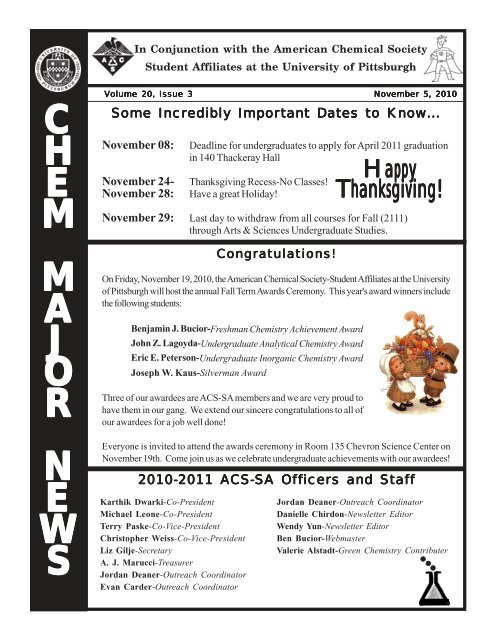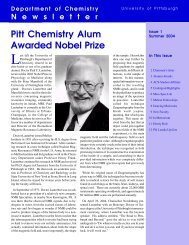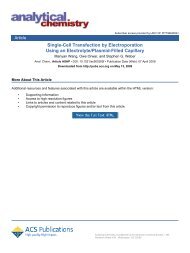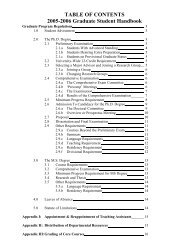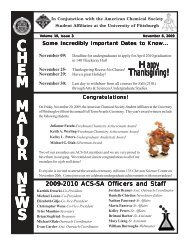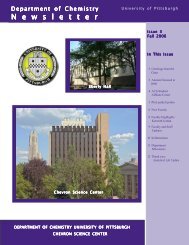C H E M M A J O R N E W S - Department of Chemistry - University ...
C H E M M A J O R N E W S - Department of Chemistry - University ...
C H E M M A J O R N E W S - Department of Chemistry - University ...
Create successful ePaper yourself
Turn your PDF publications into a flip-book with our unique Google optimized e-Paper software.
In Conjunction with the American Chemical SocietyStudent Affiliates at the <strong>University</strong> <strong>of</strong> PittsburghVolume 20, Issue 3 November 5, 2010Some Incredibedibly Important Dates to Know...CHEMNovember 08:November 24-November 28:Deadline for undergraduates to apply for April 2011 graduationin 140 Thackeray HallThanksgiving Recess-No Classes!Have a great Holiday!HappyThanksgiving!November 29: Last day to withdraw from all courses for Fall (2111)through Arts & Sciences Undergraduate Studies.Congratulations!MAJOROn Friday, November 19, 2010, the American Chemical Society-Student Affiliates at the <strong>University</strong><strong>of</strong> Pittsburgh will host the annual Fall Term Awards Ceremony. This year's award winners includethe following students:Benjamin J. Bucior-Freshman <strong>Chemistry</strong> Achievement AwardJohn Z. Lagoyda-Undergraduate Analytical <strong>Chemistry</strong> AwardEric E. Peterson-Undergraduate Inorganic <strong>Chemistry</strong> AwardJoseph W. Kaus-Silverman AwardThree <strong>of</strong> our awardees are ACS-SA members and we are very proud tohave them in our gang. We extend our sincere congratulations to all <strong>of</strong>our awardees for a job well done!NEEveryone is invited to attend the awards ceremony in Room 135 Chevron Science Center onNovember 19th. Come join us as we celebrate undergraduate achievements with our awardees!2010-2011 ACS-SA Officericers and StaffWSKarthik Dwarki-Co-PresidentMichael Leone-Co-PresidentTerry Paske-Co-Vice-PresidentChristopher Weiss-Co-Vice-PresidentLiz Gilje-SecretaryA. J. Marucci-TreasurerJordan Deaner-Outreach CoordinatorEvan Carder-Outreach CoordinatorJordan Deaner-Outreach CoordinatorDanielle Chirdon-Newsletter EditorWendy Yun-Newsletter EditorBen Bucior-WebmasterValerie Alstadt-Green <strong>Chemistry</strong> Contributer
Our November ScheduleNovemberember 05 Cognitive Science Educationwith Dr. Chandra Singh, <strong>Department</strong> <strong>of</strong> Physics12 Fall Term Birthday Bash19 Fall Term Awards CeremonyJoin us as we celebrate academic excellence!26 Thanksgiving Break--Enjoy!Everyone is welcome to attend our weekly ACS-SA meetings.Every Friday at noon we get together in 135 ChevronScience Center to hear interesting talks, learn more aboutscience and enjoy each other's company. Come join us forall <strong>of</strong> the above mentioned meetings.Saturday ScienceAcademyLooking for something fun to do on December 04, 2010?Try Saturday Science! It is an opportunity to help ambitiousarea high school students learn both general and organicchemistry in the lab. With your help, the students get tomake crystal gardens, do a simple thin layerchromatography experiment, witness an acid base reactionwith dry ice, measure the pH <strong>of</strong> some favorite s<strong>of</strong>t drinks,and synthesize slime. Volunteers will play the role <strong>of</strong> ateacher: demonstrating the experiments, helping thestudents perform them, and finally, answering theirquestions. Saturday Science is a fun and rewardingvolunteer experience in chemistry. So, are you still lookingfor something fun to do in the New Year? Join us for theACS-SA meeting on Friday, December 3, 2010 at NOONin 135 CHVRN to plan for this great day. If you cannotbe there on Friday, e-mail Jordan, our Outreach Coordinatorat jdd42@pitt.edu and let him know you're interested inhelping out and then join us on Saturday, December 4, 2010at 9:00 a.m. in the Chevron Lobby.ComedyCorner...
Food, Football, and Science:Counting Our Blessings...Thanksgiving means two things thesedays: food and football. In fact the appeal <strong>of</strong> bothis probably the reason that we keep this holidayaround. Yet, I wonder if it is about somethingmore. Perhaps, it is about Captain MylesStandish and the 100 (or was it 200?) pilgrimswho landed on that rock. Then again, if it was, Imight know the story better. What is Thanksgivingabout then? I have <strong>of</strong>ten pondered this whilestuffing myself with tryptophan rich turkey and drifting<strong>of</strong>f under its serotonine induced calmness. Afterall my pondering though, I have decided that itis about exactly what its name says: giving thanks.Now, I know as much as the next babbling editorthat this can be difficult when faced with the feudsor awkward conversation sometimes accompanyingthe Thanksgiving gathering. However, wetruly are blessed. We should give thanks for ourloved ones especially those who do not causethe feuds, make really good pie, or pick us upfrom lab late at night. Moreover, we should bethankful for the opportunity to study science andtechnology here at Pitt. This is an opportunitywhich so many around the world do not have, andit gives us the power to really cause a change inthe way people live. Of course, this can seem farfetchedwhile cramming for ochem or getting lostin a pchem derivation, but when you think aboutit, science has made life so much better just inour years on the planet.by: Danielle Chirdon, Senior EditorTake lithium ion batteries for example.They consist <strong>of</strong> a carbon anode and a metal oxidecathode separated by a micro perforatedplastic permeable to ions. When a lithium batteryis charged, lithium ions reside at the anode, butas electrons leave the anode, lithium ions flowthrough an organic solvent to the cathode wherethey create a positive charge keeping the electronsflowing. Due to the lightness <strong>of</strong> lithium, theLi + batteries have unsurpassed energy to weightratios providing the portable energy needed forcell phones and notebooks. Moreover, the batteriesare rechargeable, so they power our devicesfor years without being replaced. Just imagine,without the incredible advancements in thesebatteries, lifting a cell phone might be a workoutand buying batteries might drain our wallets likebuying minutes.Digital cameras have also hit the scenein recent years eliminating film and those covetedfinger over the lens shots. These deviceshave been made possible through the development<strong>of</strong> photodiode arrays. In these arrays, junctionsseparate patches <strong>of</strong> n-type silicon with freeelectrons from p-type silicon containing positiveareas called holes. Holes and electrons attractone another to the junctions, but they can be drawnapart with applied voltage which places positivepotential at the n-type silicon and negative potentialat the p-type silicon. When such voltage isapplied, charges are separated and the array issaid to be fully charged. Once light hits the siliconpatches though, electrons and holes flow towardsthe junction eliminating charge separation.The extent to which each area <strong>of</strong> the array is dischargedis measured to determine how muchlight hit that area, and readings from each areaare combined in images: your photos. This technologynot only has revolutionized photographybut increases speed and ease <strong>of</strong> spectroscopyby allowing employed wavelengths to be detectedsimultaneously once they have been separatedand aimed at separate parts <strong>of</strong> the array.In addition to using lithium batteries or photodiodearrays, the cell phones and cameras onwhich we have come to depend also employ LCDor liquid crystal display technology. Unlike cathodetube displays or other predecessors, LCDscan be small enough and light enough to fit intoportable devices. At the same time, they drawmuch less energy than other displays makingthem a great option for quality, energy saving televisionsor scoreboards. The nematic liquid crystalsutilized in these displays are rod shapedmolecules which can flow like liquids but are
aligned in ordered crystalline regions like solids.When light strikes liquid crystals, the crystalschange the light’s plane <strong>of</strong> vibration so thatit runs parallel to the direction <strong>of</strong> their alignment.In a display, the liquid crystals are between polarizingfilters. They are aligned so that lightshined through them from inside the screen istwisted to fit through the foremost filter andemerges from the screen. To create an image,voltage is applied to the liquid crystals and twiststhem causing them to twist the light. Light thenno longer goes through the foremost polarizingfilter, so areas <strong>of</strong> the liquid crystal display wherevoltage is applied appear dark. Color is generatedby using color filters.Last but certainly not least is a new innovationcalled the flash drive. Do you rememberwhat living without flash drives was like? To refreshyour memory, it involved breaking up asingle powerpoint presentation between four orfive floppy disks and hoping not to hear thatdreadful sound which meant that the floppy wasspinning but was not going to open. Now though,we can save so much on just a tiny drive. In fact,if you have ever lost a flash drive, then you knowthat it can seem as if your whole life is savedthere. The material behind flash drives is Floating-GateAvalanche-Injection Metal Oxide Semiconductor.The science is somewhat complexlike the name, but basically, flash drives containcells <strong>of</strong> the semiconductor which each have acontrol and a floating gate to control electronflow. The gates are separated by a metal oxideinsulator and voltage is applied across the cellcausing a current to flow out <strong>of</strong> a bit line attachedto the floating gate. This current can then be directedfrom the floating gate through the controlgate creating a link between the two gates readas a binary 1. However, if electrons are transportedpast the floating gate into the insulatorby quantum mechanical tunneling or anothermechanism, the electrons become stored in theinsulator and repel electrons flowing from thefloating gate towards the control gate. Contactbetween the gates is lost, and current is redirectedfrom the floating gate to a cell sensor codingfor a binary 0. Thus, in short, data can bestored as electrons trapped in metal oxide insulators<strong>of</strong> semiconductor cells, and it is read bytranslating the path <strong>of</strong> current in those cells intobinary code.Beyond all <strong>of</strong> the great technologies alreadyspoiling us, new technologies are comingever closer to changing the world. Piezoelectricalmaterials which produce electrical current whenbent are being developed and may someday beplaced in rivers to produce electricity from thewater’s movement. Poplar proteins with silicananoparticles attached to their pores are beingused as memory elements which carry out computingfunctions and provide high capacity datastorage without using dwindling rare earth elements.Meanwhile, at Washington State <strong>University</strong>,scientists are developing huge sails whichcould be put into space to capture energy fromsolar winds. Energy from such sails would besent to Earth using an infrared laser beam andmay equate to 10 billion times the energy whichEarth currently uses.Who knows… Maybe one <strong>of</strong> us will developthese fledgling technologies or some otherbig advancement. This is the opportunity whichwe have been given and the opportunity for whichwe should always be thankful. Of course, beingthankful for family, turkey, or pie is not a bad ideaeither on Thanksgiving. Enjoy your holiday everyone.Let’s eat.Sources:Stevens, Malcolm P. Polymer <strong>Chemistry</strong>: An Introduction.New York: Oxford <strong>University</strong> Press,1999.Harris, Daniel C. Quantitative Chemical Analysis7 th ed. New York: W.H. Freeman and Company,2007.http://www.popsci.com/http://electronics.howstuffworks.comhttp://usb-facts.com/index.htm
Do you know what’s on your Thanksgiving table? FWhat terpenoid makes carrots orange?_______Cranberries contain what aromatic substance responsible forFor what do the antioxidants in cranberries scavenge in yourWhat substance allows Jello to be a sort <strong>of</strong> colloidal suspensWhat is the above answer made from? (On secondthought, skip this… if you really like Jello, youdon’t want to know)Yams are a good source <strong>of</strong> what alkali metal? ____What molecule is responsible for the sweet taste <strong>of</strong>puddings and pies? ____________Gravy is rich in the worst kind <strong>of</strong> fat. What type <strong>of</strong>fat is that? __________
Special thanks to Ms. Danielle Chirdon for her great service as ourChem Major News Editor for the past two years. Thanks Danielle!<strong>University</strong> <strong>of</strong> PittsburghAMERICAN CHEMICAL SOCIETY-STUDENT AFFILIATESDear Friends:Goodbyes are not my strong suit, but here we are again at another turning point, a fork stuck in theroad. Oh wait, that’s a Green Day song… I probably should be a little more original. Well, what I actuallywant to say amidst the end <strong>of</strong> semester and (for some <strong>of</strong> us) end <strong>of</strong> college excitement/anxiety/drama isreally quite simple: Thanks.I showed up here four and a half years ago finding Pitt’s 9,000 buildings hard to navigate, calling classtimes periods, associating fishbowls with fish, and thinking that four years sounded like an eternity. I was soconfused that I actually thought that I would major in something besides chemistry before seeing the light (thespark <strong>of</strong> a magnesium turning in gen. chem no doubt). I also wondered, as many <strong>of</strong> you probably have, if Pittreally was it, the right choice. After four years which have felt like the blink <strong>of</strong> an eye, I can now answer thatinquiry with a definitive yes.The past few semester alone, I was welcomed into Dr. Chapman’s lab to get a taste <strong>of</strong> real synthesis,and in the proces, I helped (probably only slightly) to make polymers which may someday save lives as drugdelivery agents. I also presented my research in the carbon capture field to my peers and pr<strong>of</strong>essors atScience 2009. Oh and, through this newsletter, I was able to speak to all <strong>of</strong> you and hopefully, to make youlaugh. Doing so has been my pleasure, and I encourage anyone who likes to write at all to talk to Georgeabout becoming an editor.Beyond just me, the entire ACS group had some awesome experiences over the past year. ACSstudents spent Saturdays sharing their love <strong>of</strong> chemistry with high school students to encourage them toexplore their potential. With activities and demonstrations, ACS students also took the wonder <strong>of</strong> chemistry toSt. Agnes School and Good Shepherd School. Because charity starts at home, the ACS provided tutoring inthe fishbowl for general and organic chemistry. Lastly and probably least, hungry ACS students polished <strong>of</strong>fquite a few pizzas.But <strong>of</strong> course, what is college without classes? I have had some awesome ones and some painstakinglydifficult ones. Really though, I could not ask for a better opportunity than the chance to study at Pitt, andI could not think <strong>of</strong> a better group <strong>of</strong> people.So wrapping it up, I want to say thanks. Thanks to the pr<strong>of</strong>essors who help students gain laboratoryexperience and who go the extra mile so that students walk away with knowledge in their brains rather thanin their textbooks. Thanks to friends and study groups who help all <strong>of</strong> us motor through the tougher times.Thanks to all those who make the meeting <strong>of</strong> the minds (ACS, what else?) possible and especially to Georgefor being a friend instead <strong>of</strong> a Director <strong>of</strong> Undergraduate Studies. Thanks for 4.5 great years.To those <strong>of</strong> you who expect to graduate this December like me, we did it… congratulations. I amreaching for the Kleenex box right now, but I want to wish you the best <strong>of</strong> luck. I hope that Pitt has been it,and more than that, I hope it has become home. No matter where you will be or what you will be doing nextyear, we will always be Pitt, and that means that we can do anything.Best wishes,Danielle Chirdon


